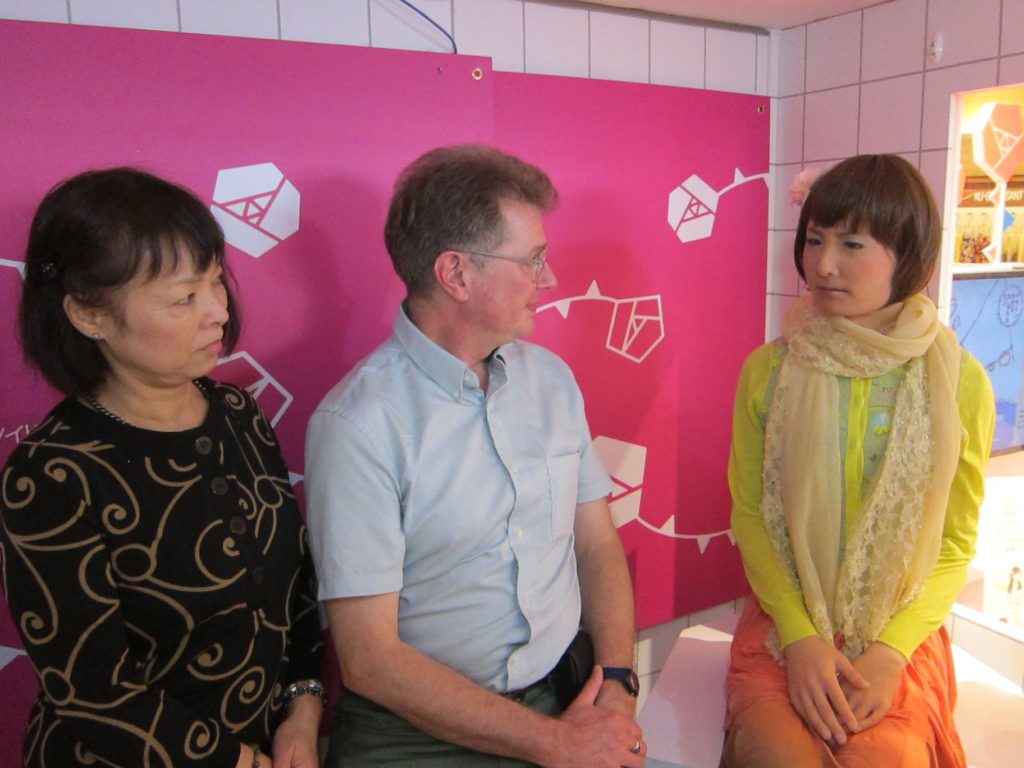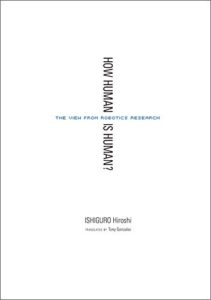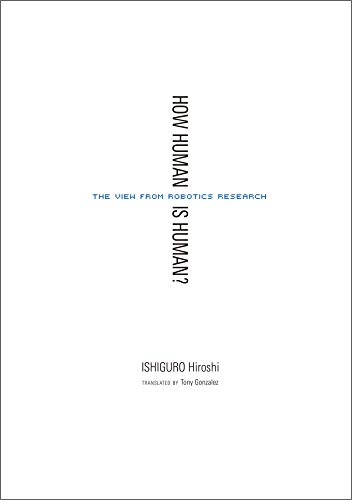The Other Ishiguro
Review by Cody Poulton
Last month in Books on Asia I reviewed Klara and the Sun and contrasted Kazuo Ishiguro with another author with the same surname. Well, here’s a book by the other Ishiguro, Hiroshi, who happens to make robots—and not just imagine them.
Ishiguro Hiroshi is probably the most famous robotics engineer around. Many will be familiar with his android double, Geminoid HI-1, released in 2006, which has had several incarnations since. Ishiguro has had himself updated by cosmetic surgery so that he and his Geminoid twin continue to resemble each other. He has created a number of other Geminoids as well: his daughter; a newscaster; an anonymous woman who was the model for his hardworking Geminoid F (more on her later); the rakugo artist Katsura Beichō; trans TV personality Matsuko Deluxe; and even the early 20th century novelist Natsume Sōseki (with the voice of his grandson, manga artist and scholar Natsume Fusanosuke).
In this manner Ishiguro Hiroshi has kept himself in the limelight for close to twenty years, while publishing dozens of academic papers in both Japanese and English, appearing on a number of Ted Talks, and even cameo-appearing in a Hollywood movie. He has also written a sheaf of popular books. How Human is Human? (Transl. Tony Gonzalez) is one of them.
Androids have been the stuff of Hollywood for decades now: Harrison Ford and Rutger Hauer in Blade Runner, Arnold Swarzenegger in the Terminator series and Alicia Vikander as android femme fatale in Ex Machina. These days even sheep dream of androids.
But we need to distinguish between science fiction and scientific fact. As Ishiguro Hiroshi would be first to admit, we are still years away from fully autonomous bots. His Geminoids are essentially paraplegic because their legs are needed to accommodate the compressors that power the pneumatic actuators that serve like muscles to move their upper bodies and simulate the expressions of joy, doubt, sadness, or annoyance that we normally associate with living humans.
Japan has been at the vanguard of the creation of robots since the implementation of industrial robots in the car industry in the 1970s, and with humanoid robots since at least 2000. Indeed, one could argue that Japan’s robotics industry reaches back to the Edo era with the production of mechanical dolls from the late-17th century on. The father of one of the founders of Toshiba was an inventor of automata. Most robotics and AI research in the US is driven by DARPA (the Defense Advanced Research Projects Agency), but Japan’s postwar constitution prevents robotics research from being used, for the most part, for anything but commercial applications. This is one of the reasons why Japanese robots are generally cute, not scary.

Cutting-edge research for the past couple of decades has been in the area of human-robot interaction (HRI), developing new generations of robots that can interact with, and assist, human beings in a variety of spheres, from staffing a fleet of fully automated hotels (Henn na Hotel) to elder care. Anthropologist Jennifer Robertson has argued, however, that Japan’s robotics industry has been in part driven by a certain xenophobic tendency to avoid immigration to mitigate Japan’s ageing demographic and labour shortage. Indeed, for this reason, Shinzō Abe’s first cabinet touted robotics in its “Innovation 25” campaign of 2007, an initiative Abe would continue to promote throughout his second tenure as Prime Minister.
But the question remains: What are androids good for? Ishiguro’s own research has been guided by an attempt to understand what makes humans tick by attempting to build one. He believes that his various attempts have led to some striking insights into human nature.
Ishiguro is an engaging speaker and his controversial, counterintuitive, man-from-Mars opinions on the nature of humanity and the future of human-robot interactions, in addition to his own technological achievements, are well-known. A materialist and determinist par excellence, he casts doubt on our received notions about the uniqueness of humanity, our sense of possessing a free will, an identity, a soul. Western philosophy has been haunted by mind-body dualism, what English philosopher Gilbert Rile called “the ghost in the machine,” since at least Descartes. Ishiguro would like to disabuse us of that notion. “‘I’ am a fragile array of sensations” he writes (p. 42), which sounds rather like the Buddhist concept of self-hood.
I met the author, who has a Doctorate in Engineering from Osaka University, through one of his colleagues, playwright and director Hirata Oriza. Ishiguro and Hirata first teamed up to create what is claimed to be the world’s first play in which robots are robots: I Worker (2008). The two creators would go on to produce several more, including Sayonara, starring Geminoid F in a two-hander with the Geminoid and American actress Bryerly Long playing a mortally ill woman. (For translations of these plays see Poulton and Hirata, 2019.)
Refreshingly for an engineer, Ishiguro has been an avid interdisciplinarian, working with neurologists, cognitive scientists, linguists, and artists in his ongoing efforts to map out human consciousness and replicate that in machines. Curiosity about human nature has driven his research, not the need to translate it into commercial applications. In this sense, Ishiguro is a pure scientist, not just some inventor.
Some of the most intriguing sections of How Human is Human? discuss telepresence, the feeling that our consciousness can inhabit an object or entity at physical remove from ourselves. (To some extent this is what Marshall McLuhan was getting at back in the 1960s when he wrote that electronic media are essentially extensions of our central nervous system.) Operators of Ishiguro’s Geminoids, including himself, identify so much with their doppelgangers that when their androids are touched they feel it physically. Ishiguro has frequently sent his Geminoid overseas to give lectures, which he can still deliver in his own voice over the internet. If our minds are not in our bodies, then where are they? This further complicates the Cartesian problem.
Androids are certainly tools to think with and one thing they make us think of is our own mortality. That was Hirata’s take in Sayonara and Kazuo’s take too in Klara and the Sun. Hiroshi, who is something of a trans-humanist, would like to think of androids as a way to become immortal. He wonders whether it would be possible to download his identity, his memories, his emotions, into his android double. If we all had one, could we then live vicariously through our surrogates, perhaps extending our lives, not only in space, but beyond our limited time on this planet?
What is elided here is that Ishiguro Hiroshi’s robots are essentially puppets that still mostly need to be operated by a human being. As of yet, they do not possess autonomy or agency. After some years of seeking the roboticist’s Total Turing Test—to build an android that can fool you into thinking it’s human—Ishiguro turned to making more idealized humanoid forms, in various shapes and sizes, to act as tools of communication and intimacy between individuals separated by distance: smart phones if you will, that feel like human flesh and respond to your touch. In truth, however, his Telenoids and Elfoids haven’t replaced our iPhones or Androids (a misnomer, that one). Nobody outside Ishiguro and the folks in his lab carry little homunculi in their pockets. They’re not cute, like Aibo, Pepper or the huggable LOVOT, and we know that in Japan, cute is queen. The current pandemic has driven home the need for new ways of intimacy in a world of physical distancing; if technology can’t solve the problem, at least it is ameliorating it.
A leitmotif in this book is Ishiguro’s sense that he is becoming more and more like his Geminoid, rather than the other way around. This is a feeling first flagged by Donna Haraway in her “Cyborg Manifesto” of 1985, where she writes that “our machines are disturbingly lively, and we ourselves frighteningly inert.” (Haraway herself has a cameo in Ghost in the Shell 2: Innocence [2002].) Technology is undoubtedly transforming what it means to be human, but it’s been doing that since the birth of homo sapiens. Sherry Turkle has also had much to say about recent iterations of this problem.
If I had a bone to pick with this book, it would be, first, the English title. “How human is human?” asks nothing, and provides no answers. More evocative is the original title, Dōsureba Hito o Tsukureru ka: Andoroido ni Natta Watakushi, which literally translates as “How can one make a human? I, who became an android.” Better yet, call it, à l’Azimov, “I, Android.” There is another problem: the original Japanese text was published in 2011. A whole decade has passed since then and, while we still haven’t reached the singularity, robotics research has grown by leaps and bounds. Ishiguro’s book is therefore a report on the state of his corner of the field, but it is no longer up to date.
The biggest issue with this book is that Ishiguro has been digging a trench in the Uncanny Valley for so many years now in an effort to marry resemblance to familiarity but only getting weirder. Simulation isn’t identity and “humanness” (ningen rashisa) isn’t humanity. He’s the first to admit he hasn’t cracked that mystery, however, so let’s give him some credit for trying.


